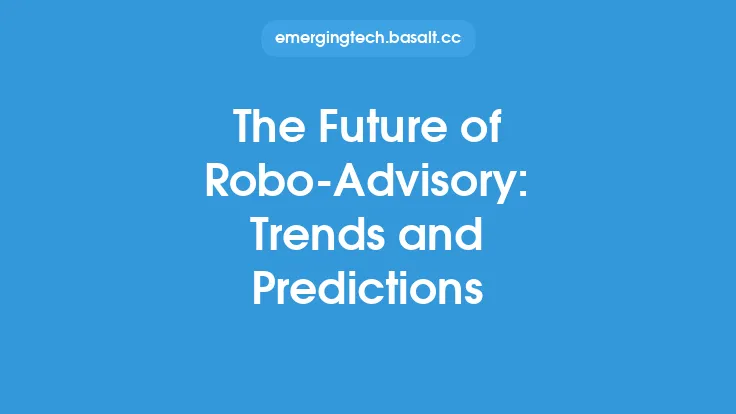The cybersecurity landscape is constantly evolving, with new threats and vulnerabilities emerging every day. As a result, vulnerability management has become a critical component of any organization's cybersecurity strategy. Vulnerability management is the process of identifying, classifying, prioritizing, and remediating vulnerabilities in an organization's systems, networks, and applications. In this article, we will explore the future of vulnerability management, including trends and predictions that will shape the industry in the years to come.
Introduction to Vulnerability Management Trends
Vulnerability management is a rapidly changing field, driven by advances in technology and the increasing sophistication of cyber threats. One of the key trends in vulnerability management is the shift towards proactive and predictive approaches. Rather than simply reacting to vulnerabilities as they are discovered, organizations are now using advanced analytics and machine learning to predict and prevent vulnerabilities from occurring in the first place. This approach requires a deep understanding of the organization's systems, networks, and applications, as well as the threats that they face.
The Role of Artificial Intelligence in Vulnerability Management
Artificial intelligence (AI) and machine learning (ML) are playing an increasingly important role in vulnerability management. These technologies can be used to analyze vast amounts of data, identify patterns, and predict vulnerabilities before they are exploited. AI-powered vulnerability management tools can also help organizations to prioritize and remediate vulnerabilities more effectively, by providing real-time risk assessments and recommendations for mitigation. For example, AI-powered tools can analyze network traffic and system logs to identify potential vulnerabilities, and then provide recommendations for patching or mitigation.
The Importance of Cloud Security in Vulnerability Management
The increasing adoption of cloud computing is also having a major impact on vulnerability management. Cloud-based systems and applications are vulnerable to many of the same threats as on-premises systems, but they also introduce new risks and challenges. For example, cloud-based systems may be more vulnerable to data breaches and unauthorized access, due to the lack of physical controls and the potential for misconfigured security settings. As a result, organizations must prioritize cloud security as part of their vulnerability management strategy, by implementing robust security controls and monitoring cloud-based systems and applications for potential vulnerabilities.
The Rise of DevSecOps and its Impact on Vulnerability Management
DevSecOps is a relatively new approach to software development and security, which emphasizes the integration of security into the development process from the outset. This approach is having a major impact on vulnerability management, by helping organizations to identify and remediate vulnerabilities earlier in the development cycle. DevSecOps tools and practices, such as continuous integration and continuous delivery (CI/CD), can help organizations to automate vulnerability management and reduce the risk of vulnerabilities being introduced into production environments.
The Growing Importance of IoT Security in Vulnerability Management
The increasing adoption of Internet of Things (IoT) devices is also introducing new challenges and risks for vulnerability management. IoT devices are often vulnerable to exploitation, due to weak passwords, outdated software, and lack of security controls. As a result, organizations must prioritize IoT security as part of their vulnerability management strategy, by implementing robust security controls and monitoring IoT devices for potential vulnerabilities. This may involve implementing secure coding practices, conducting regular security audits and penetration testing, and ensuring that IoT devices are properly configured and patched.
The Evolution of Vulnerability Scanning and Assessment
Vulnerability scanning and assessment are critical components of any vulnerability management strategy. These processes involve using specialized tools and techniques to identify and classify vulnerabilities in an organization's systems, networks, and applications. The evolution of vulnerability scanning and assessment is being driven by advances in technology, including the increasing use of AI and ML to improve the accuracy and effectiveness of vulnerability scanning. For example, AI-powered vulnerability scanning tools can analyze network traffic and system logs to identify potential vulnerabilities, and then provide recommendations for patching or mitigation.
The Future of Vulnerability Management: Predictions and Trends
So what does the future hold for vulnerability management? Here are some predictions and trends that are likely to shape the industry in the years to come:
- Increased use of AI and ML to improve the accuracy and effectiveness of vulnerability management
- Greater emphasis on proactive and predictive approaches to vulnerability management
- Growing importance of cloud security and IoT security in vulnerability management
- Increased adoption of DevSecOps and other security-focused development practices
- Greater use of automation and orchestration to streamline vulnerability management processes
- Increased focus on vulnerability management metrics and key performance indicators (KPIs) to measure the effectiveness of vulnerability management programs.
Conclusion
In conclusion, the future of vulnerability management is likely to be shaped by a range of trends and predictions, including the increasing use of AI and ML, the growing importance of cloud security and IoT security, and the adoption of DevSecOps and other security-focused development practices. By understanding these trends and predictions, organizations can better prepare themselves for the challenges and opportunities of vulnerability management in the years to come. Whether you are a security professional, a developer, or a business leader, it is essential to stay informed about the latest developments in vulnerability management, and to prioritize vulnerability management as a critical component of your organization's cybersecurity strategy.





